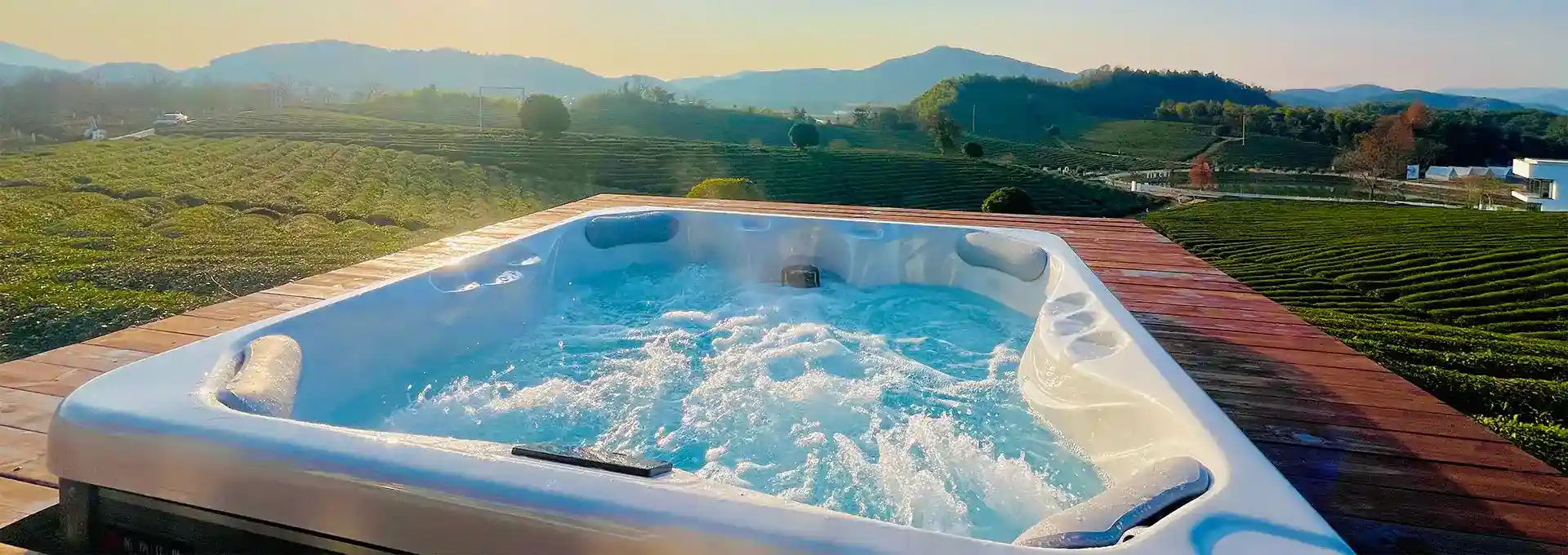Would a Spa Have a Swimming Pool?
2024-09-20 11:26:41
When you think of a spa, what comes to mind? Relaxing massages, facial treatments, and perhaps a sauna or hot tub? While these are common features of many spas, you might be surprised to learn that some spas also offer swimming pools. In fact, the combination of spa services and swimming facilities has become increasingly popular in recent years, blending the benefits of hydrotherapy with traditional spa treatments. This trend has given rise to a new concept: the outdoor swimming spa. Let's dive deeper into this topic and explore some common questions people have about outdoor swimming spas.
What are the benefits of an outdoor swimming spa?
An outdoor swimming spa offers a unique blend of relaxation, exercise, and nature immersion that can provide numerous physical and mental health benefits. First and foremost, swimming is an excellent form of low-impact exercise that works the entire body. It's particularly beneficial for individuals with joint issues or those recovering from injuries, as the water's buoyancy reduces stress on the body while still providing resistance for muscle strengthening.
The outdoor setting of these swimming spas adds another layer of benefits. Exposure to natural sunlight while swimming can boost vitamin D production, which is essential for bone health and immune function. The fresh air and natural surroundings can also contribute to stress reduction and improved mental well-being. Many people find that being in nature helps them feel more grounded and relaxed, making the outdoor swimming spa experience even more rejuvenating than indoor alternatives.
Moreover, outdoor swimming spas often incorporate features of both traditional swimming pools and hot tubs. This means you can enjoy the invigorating effects of cool water swimming followed by the soothing warmth of a spa jet massage. This contrast in temperatures, known as contrast hydrotherapy, can help improve circulation, reduce inflammation, and promote faster recovery after physical activity.
The social aspect of outdoor swimming spas shouldn't be overlooked either. These spaces often become gathering points for friends and family, encouraging social interaction and bonding. Whether you're enjoying a leisurely swim with loved ones or participating in a water aerobics class, the communal nature of these spaces can enhance your overall spa experience and contribute to a sense of community well-being.
Lastly, many outdoor swimming spas are designed with aesthetics in mind, featuring beautiful landscaping, waterfalls, or other natural elements. This creates a serene and visually appealing environment that can enhance the overall relaxation experience. The combination of beautiful surroundings, the sound of moving water, and the physical benefits of swimming can create a multi-sensory experience that goes beyond what a traditional indoor spa or pool can offer.
How does an outdoor swimming spa differ from a regular pool?
While both outdoor swimming spas and regular pools offer the opportunity for aquatic activities, there are several key differences that set them apart. Understanding these distinctions can help you appreciate the unique features and benefits of an outdoor swimming spa.
Size and Design: One of the most noticeable differences is the size and design. Regular pools are typically larger and designed primarily for swimming laps or recreational activities. They often have a uniform depth and may include diving areas. In contrast, outdoor swimming spas are usually smaller and more compact. They're designed to maximize space efficiency while still providing enough room for swimming and other water-based activities. The design often includes varying depths and built-in seating areas, making them more versatile for different uses.
Temperature Control: Unlike regular pools, which are usually kept at a consistent, cooler temperature, outdoor swimming spas often feature advanced temperature control systems. This allows users to adjust the water temperature according to their preferences or the intended use. For example, the temperature can be lowered for more invigorating swims or raised for a more relaxing, spa-like experience. This flexibility makes outdoor swimming spas suitable for year-round use, even in cooler climates.
Jet Systems: A defining feature of outdoor swimming spas is the incorporation of powerful jet systems. These jets serve multiple purposes. They can create a current for swimmers to swim against, providing a more challenging workout in a smaller space. This feature, often called a swim current or endless pool, allows for stationary swimming – perfect for exercise in a compact area. Additionally, the jets can be used for hydrotherapy, targeting specific muscle groups for massage and relaxation, similar to a traditional spa or hot tub.
Integrated Features: Outdoor swimming spas often come with a range of integrated features that you wouldn't typically find in a regular pool. These may include built-in seating areas with massaging jets, underwater lighting systems, water features like waterfalls or fountains, and even audio systems. Some models also incorporate separate hot tub sections, allowing users to enjoy both cool and warm water experiences in the same unit.
Energy Efficiency: Due to their smaller size and advanced insulation techniques, outdoor swimming spas are generally more energy-efficient than traditional pools. They require less water to fill and maintain, and the smaller volume of water is easier to heat and keep at a desired temperature. Many models come with energy-efficient pumps and heating systems, as well as insulated covers to minimize heat loss when not in use.
Maintenance: The maintenance requirements for an outdoor swimming spa typically differ from those of a regular pool. While both require regular cleaning and chemical balancing, the smaller size of a swimming spa often means less time and effort spent on maintenance. Many swimming spas come with advanced filtration systems and self-cleaning features that can simplify the upkeep process.
Versatility: Outdoor swimming spas offer a level of versatility that regular pools can't match. In a single, compact unit, users can engage in a variety of activities – from vigorous swimming workouts to relaxing hydrotherapy sessions. This multi-functionality makes them particularly appealing for those with limited space or those who want to combine the benefits of a pool and a spa in one installation.
Installation and Portability: Unlike traditional in-ground pools, many outdoor swimming spas can be installed above ground or even semi-inground. This can make the installation process quicker, less invasive, and potentially more cost-effective. Some models are even designed to be portable, allowing for relocation if needed – something that's not possible with a traditional pool.
Can you use an outdoor swimming spa year-round?
One of the most appealing aspects of an outdoor swimming spa is its potential for year-round use, even in regions with distinct seasons. Unlike traditional outdoor pools, which often sit unused during colder months, outdoor swimming spas are designed with features that make them suitable for all-season enjoyment. However, using an outdoor swimming spa year-round does come with some considerations and may require some additional equipment or preparations depending on your local climate.
In warmer months, using an outdoor swimming spa is straightforward. The ability to control water temperature means you can keep the water cool enough for refreshing swims on hot days. Many users find that a temperature around 80-85°F (27-29°C) is ideal for exercise swimming in summer. The outdoor setting allows you to soak up the sun, enjoy the fresh air, and perhaps even do some stargazing during evening swims.
As the weather begins to cool in autumn, the versatility of an outdoor swimming spa really shines. You can gradually increase the water temperature to maintain comfort as the air temperature drops. This extended swimming season is one of the key advantages over traditional pools. Many swimmers find that slightly warmer water (around 86-90°F or 30-32°C) is perfect for fall swimming, providing a cozy contrast to the crisp air.
Winter use of an outdoor swimming spa requires more consideration but is entirely possible and can be a uniquely enjoyable experience. Here are some key factors to keep in mind:
1. Heating Efficiency: Modern outdoor swimming spas are designed with excellent insulation to minimize heat loss. Many come with high-efficiency heaters that can maintain comfortable water temperatures even in freezing conditions. However, it's important to note that heating costs will likely increase during colder months.
2. Covers: A well-insulated, tight-fitting cover is crucial for winter use. It helps retain heat when the spa is not in use and prevents snow and debris from entering the water. Some advanced covers even have automatic systems that can withstand snow loads.
3. Surrounding Area: The deck or patio around your outdoor swimming spa may become slippery in winter conditions. Consider installing non-slip mats or heating elements in the surrounding area for safety.
4. Winterization Equipment: In extremely cold climates, you might need additional equipment like floating de-icers or circulation pumps to prevent the water from freezing.
5. Maintenance: Winter maintenance might require some extra steps, such as more frequent checking of chemical levels and ensuring that all components are functioning properly in the cold.
The experience of using an outdoor swimming spa in winter can be truly magical. Imagine swimming in warm water while snowflakes fall around you, or enjoying a relaxing soak under a clear, starry winter sky. Many users find that the contrast between the warm water and the cold air creates a uniquely invigorating sensation.
Spring brings its own joys to outdoor swimming spa use. As the weather warms, you can gradually lower the water temperature, using the spa as a refreshing retreat. This season is perfect for combining swim workouts with relaxation sessions, taking advantage of the spa's dual nature.
Year-round use of an outdoor swimming spa also provides consistent access to the health benefits of swimming and hydrotherapy. Regular aquatic exercise can improve cardiovascular health, build strength and endurance, and aid in weight management. The massaging jets can help alleviate muscle tension and joint pain throughout the year.
Moreover, having a usable water feature in your outdoor space all year long can significantly enhance your home's livability and potentially its value. It becomes a focal point for outdoor entertaining in every season, from summer pool parties to cozy winter gatherings.
While year-round use is possible, it's important to consult with the manufacturer or a pool professional about the specific requirements for your climate. They can provide guidance on the best practices for maintaining your outdoor swimming spa throughout the year and may recommend specific models designed for four-season use in your area.
In conclusion, an outdoor swimming spa offers the unique opportunity to enjoy the benefits of swimming and hydrotherapy regardless of the season. With proper equipment and care, it can become a year-round oasis in your backyard, providing a space for exercise, relaxation, and enjoyment no matter what the weather brings.
For more information on hot tub installations and to find out more about our products, please feel free to contact us at info@iparnassus.com.
References
1. American Pool Enterprises, Inc. "The Benefits of Swimming Pool Exercises."
2. Aqua Magazine. "The Rise of Swim Spas."
3. Hydropool Swim Spas. "Year Round Use of Your Swim Spa."
4. International Hot Tub Association. "Hot Tubs vs. Swim Spas: What's the Difference?"
5. Journal of Physical Therapy Science. "Effects of aquatic exercise on health-related physical fitness, blood fat, and immune functions of children with disabilities."
6. Mater Spas. "Can You Use a Swim Spa in Winter?"
7. Pool and Spa News. "The Evolution of Swim Spas."
8. Swim University. "How to Maintain Your Hot Tub in Winter."
9. The Spruce. "What Is a Swim Spa?"
10. U.S. Masters Swimming. "The Health Benefits of Swimming."



